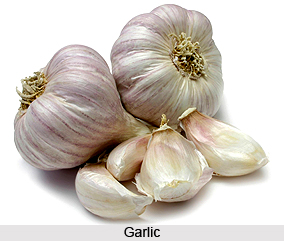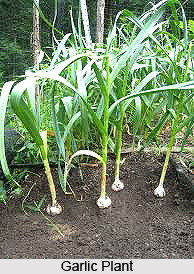 Garlic is one of the most commonly used spices in India. The garlic is composed of individual cloves enclosed in a white parchment-like skin. Each clove of garlic is encased in its own covering of papery skin. Garlic is cultivated and widely used in almost every culture in the world for its myriad medicinal as well as culinary values. Garlic is cultivated in all over India and the states of Madhya Pradesh, Gujarat, Odisha, Rajasthan, Karnataka, Tamil Nadu, Maharashtra and Bihar are the premium producers of Garlic in India.
Garlic is one of the most commonly used spices in India. The garlic is composed of individual cloves enclosed in a white parchment-like skin. Each clove of garlic is encased in its own covering of papery skin. Garlic is cultivated and widely used in almost every culture in the world for its myriad medicinal as well as culinary values. Garlic is cultivated in all over India and the states of Madhya Pradesh, Gujarat, Odisha, Rajasthan, Karnataka, Tamil Nadu, Maharashtra and Bihar are the premium producers of Garlic in India.
Etymology of Garlic
Garlic belongs to the "Lilliaceae" family and its botanical name is "Allium sativum Linn". It is known by several many names in different parts of India like "Lahsun" in Hindi and Urdu, "Rasun" in Bengali, "Rasuna" in Oriya, "Naharu" in Assamese, "Lasan" in Gujarati and Punjabi, "Lusoon" in Marathi, "Belluli" in Kannada and Malayalam, "Lahsuna" in Sanskrit , "Rahan" in Kashmiri, "Ullipundu" in Tamil and "Velluri" in Telugu.
Origin of Garlic
Since the ancient times, Garlic has been used as a valuable condiment for foods in India. Garlic has a special mention in the Hindu mythology. According to Hindu mythology, the gods and the demons once churned the sea, using earth as the axis and divine snake Basuki as the rope. Many precious materials came out due to churning of the sea. Along with the materials, a pot of nectar also came out and consuming the nectar was believed to have capacity to make one immortal. The gods and demons fought against each other for this pot and eventually, the gods took possession of the pot. The King of gods, Indra took the pot to heaven for distributing to gods. However, he first offered it to his wife Sachi, before distributing to others. After consuming it, Sachi could not digest the nectar and thus vomited. A drop of her vomit fell from heaven on the earth and a small plant emerged from that drop. This plant is known as Garlic. According to Hindu Mythology, Garlic is foul smelling because it had emerged from vomit. The mythology also mentioned that Garlic has several medicinal virtues, as it had emerged from heavenly nectar. 
Properties of Garlic
Garlic is one of the most effective antimicrobial herbs, as it has anti-bacterial, anti-fungal, anti-viral, anthelmintic and antiseptic properties.
Use of Garlic in Cuisine
Garlic has many uses. It is mostly used for culinary purposes and people all over the world use it as a condiment for different food items. In India and other Asian countries, it is used in several food preparations like chutneys, pickles, curry powders, curried vegetables, meat preparations, tomato ketchup, etc. The raw garlic can also be used in the manufacturing of garlic powder, garlic salt, garlic vinegar, garlic cheese croutons, garlic potato chips, garlic bread, etc.
Use of Garlic in Medicine
Besides the culinary usages, garlic is also well known for having numerous valuable medicinal properties. Garlic is considered one of the oldest medicines in the world and is used in making remedies for various ailments and physiological disorders. According to Ayurveda and Unani medicine, it can aid in digestion and absorption of food and is also given in flatulence. Garlic is used in treatment of the diseases like running cold, saliva formation, chronic bronchitis, respiratory catarrh, whooping cough, bronchial asthma, influenza, chronic diarrhoea, pulmonary tuberculosis, rheumatism, impotence, etc. It can also fight infection, reduce cholesterol, protect against heart diseases and stroke, control diabetes, and prevent cancer.
Many people in India often avoid using garlic even for medicinal purposes. The main reason is that, garlic has repulsive odour. However, there are some side effects of garlic, as well. Consuming large amounts of garlic can cause heartburn, especially during pregnancy. If left in contact with skin of mucous membranes, fresh garlic can also cause local irritation and ulceration.




















